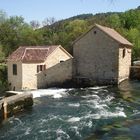river Krka (3)
The water mills on the Krka River belong to the system of pre-Industrial plants. They bear witness to the traditional way of life and earning a living that was in place until the early 20th century, with the continuity of the heritage from earlier historical periods. Along the course of the river, about 30 water mills, and several washing holes and columns have been preserved.
The best preserved, and now restored watermills are at Skradinski buk. These are an important monument of the economic past of Šibenik and the Šibenik region, and in the past were one of the main economic drivers of the city. They were first mention in a document from 1215, in which King Bela III demarcated the dividing line between Šibenik and Trogir. During the 14th and 15th centuries, the water mills on the Krka River were important for the entire Adriatic coast, as wheat was milled here for numerous towns, from Dubrovnik to Istria.
The existing water mills at Skradinski buk were predominantly built at the same place as older mills, destroyed during the Battle of Cypress and the Cretan War. They typically have rural stylistic characteristics, making it more difficult to date the structures. According to historical records, they can be dated to around the time of the end of the Turkish threat, at the turn of the 18th century. The walls of the mills were built with stone and travertine, with mortar made of a combination of limestone and sand or clay. The roof and inner construction was made of wood, and the roofing was most often stone slabs. The construction of the water mills follows the configuration of the land, and rock faces and caves were also used. Today, access to the mills is on paths made of irregular rocks.











Klickr 17/05/2013 9:11
Gefällt mir gut. Spricht die Fantasie an, ich höre förmlich das Wasser plätschern. Gruß, KlickrChristian Bertero 11/12/2012 21:23
Excellent and interesting text and composition. ++++Cordiale saluto dalla Sicilia
Christian
Janos Gardonyi 18/09/2012 18:24
well composed almost idyllic landscape in your beautiful country.(PS my son-in-law is 1/2 Croatian so my little grandson has some Croatian blood!!) best wishes Janos
W.H. Baumann 29/07/2012 20:58
A beautiful scenery, well done.LG Werner
cornelie 25/07/2012 14:34
A wonderful place. I love it.Cornelie
Surprises 12 23/07/2012 22:06
What a nice composition. Lovely light and well taken with such contrasts.Glenn Capers 21/07/2012 22:37
good find..Nuria Zortém 14/07/2012 12:22
C'est un endroit beau et paisible.Très belle image.
Salutations, Nuria
Günter Franz Müller 13/07/2012 11:37
i've seen this motiv in 2005. a great place !!!Günter
Elke N. 09/07/2012 22:13
That´s a wonderful picture and a very nice landscape, too.Very lovely!
Bye, Elke
deha 08/07/2012 20:38
very wounderfoul Photho. I like it so much...Greetings, Detlef
KORNELIUS100 08/07/2012 18:11
I LIKE +++++ COLOURS AND WATER!!! GREETINGS FROM JERUSALEMFons van Swaal 08/07/2012 16:11
BEAUTIFUL AREA ....Enjoyed being there....
Regards,
F...
Carol Orban 08/07/2012 12:54
Sehr Tolle Aufnahme!!!MfG.Carol O.
gschnaak 07/07/2012 19:53
It s a very nice Foto! I like it!